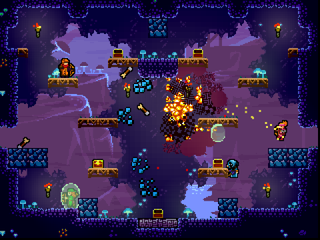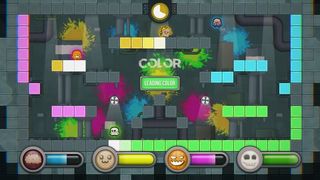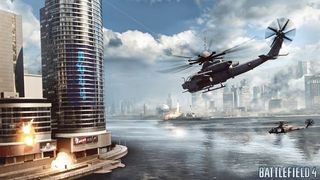Forget epics. Video games need more intimate spaces
This may sound a bit sinister, and quite possibly wildly ignorant - but I think much of video game environmental design boils down to preying on the weakness of human perception. Size and distance are, after all, as much products of the imagination as they are attributes of the objects in question, a shortcoming developers with tight resource budgets have been happy to exploit. Layer 2D silhouettes and you generate the illusion of a series of hills and ridges stretching off into the distance, at modest technical expense. Place a low-detail character model in the near-background and you create the impression of a faraway giant, stomping along the skyline, as with Ares in an early chapter from the original God of War.

These are fairly straightforward tricks. One I struggle to explain is how a videogame’s world can feel enormous simply because players have to think really, really hard about navigating it. Pack a simple 2D platforming layout with hyperactive archers and tight, precise control mechanics, as in the majestic four-player battler Towerfall, and it’ll seem at once crowded yet oddly gigantic. Combatants jostle for position, agonising over every pixel of terrain. Ledges a centimetre wide become objects of furrowed-brow calculation. Defensible nooks are fiercely contested, lines of attack uncovered and exploited. Towerfall is a game that’ll sit comfortably on a dusty old CD-ROM without touching the sides, but it often appears grander, and just as worthy of revisiting, as any sprawling, 40+ gig action opus you’d care to name.
Amid all the hype around games like The Witcher 3 or Fallout 4, with their exhaustive expanses of tundra and desert, it’s easy to forget that some of the most memorable and exacting spaces in games are also the most homely. The tiered deathtraps of Power Stone on the Dreamcast, for example, or the checkerboard maps of Advance Wars on the Gameboy Advance. These arenas are dinky in terms of their geometry - needles in the haystack that is, say, Dragon Age’s Hinterlands region - but they’re colossal in terms of the possibilities they offer and the attention they demand of the player.

GTA-style epics are very much the fashion at present. Activision continues to earn a fortune from Destiny’s huge multiplayer environments. Ubisoft has transformed Ghost Recon into a gigantic co-op sandbox, as if Assassin’s Creed, The Division and Far Cry weren’t quite enough to be getting on with. Metal Gear has abandoned the corridors of Solid Snake’s youth, to admittedly brilliant effect. EA’s executive vice-president Patrick Soderlund, meanwhile, has lamented his company’s lack of a best-selling franchise that’s as generously proportioned as “Assassin's Creed or Batman or GTA”. Skyrim’s PR mantra that if you see a mountain, you should be able to climb it, has been enshrined as holy writ. Indeed, the statement now seems positively quaint in hindsight. Of course you should be able to climb the bloody mountain. There might be a collectable or a helicopter up there, or something.
Certain indies, however, continue to find success with games that compare more readily to Pac-Man in how they place every tool and variable at your immediate disposal, providing you have the talent and guts to work your way around the screen. I don’t want to draw too sharp a line between smaller independent teams and those who work at Activision, EA or Ubisoft - the notion that every attic coder is a budding da Vinci, labouring in the service of art for its own sake, is patent fantasy. But it’s hard to play a game like, say, the wonderful Towerfall and not wonder whether the bigger studios have gotten lost in their own bloat. I’d like to see more AAA studios try their hands at projects of Towerfall’s stature - games that feel larger than they actually are on paper as a result of sharp, purposeful, economical design - rather than blowing the bank on yet another open-world.

Single-screen multiplayer games are not the antidote to epic video game burn-out, but certainly one antidote and a compelling one. For starters, single-screen multiplayer is refreshingly unambiguous. The great drawback of big multiplayer shooters, for example, is their impersonality: Thanks to the distances, headcounts and environmental granularity involved, it’s frequently unclear who exactly is doing what to whom, hence the ubiquity of killcams and directional damage indicators. This is all part of the thrill of a game like Call of Duty, of course, but it’s a divisive thrill, which stresses out less skilled or interested players even as it rewards the dedicated. By contrast, you’re never in any doubt about who the winner is in a round of, say, Boneloaf and Double Fine’s wondrous Gang Beasts. It was probably that gelatinous purple dude who just wobbled across the arena, seized you clumsily by the ear and pitched you into a grinder.
That’s not to say that single-screen multiplayer doesn’t involve its fair share of trickery and strategy - there’s nothing quite like the glee you get in Towerfall when you bait a better-armed foe into quitting the high ground. It’s just that all the basic variables and hazards are under each player’s eye from the outset. As with the best board games, the best single-screen games are works of pleasing compactness and transparency, their tactical intricacies tangible rather than cloaked in HUD noise, the quality of the underlying design everybody’s to savour
Sign up to the 12DOVE Newsletter
Weekly digests, tales from the communities you love, and more

There’s also the recent Move Or Die, a cracking four-player action-platformer with single-screen maps, in which matches last no longer than 20 seconds. Its modes range from passing a bomb to other players before it explodes, through simply making it to the exit, to painting all blocks in the environment your character’s colour by running over them. A grizzled Battlefield veteran might turn their nose up at such fleeting, hectic entertainment, but there’s every bit as much wit and strategy in a round of Move or Die as in a round of Conquest - it’s just that the options you digest are communicated much faster, are much more contained, and are offered up without the hindrance of a wider, tactical overlay.
Is it worth breaking off pursuit of one player to ambush another? Can you engineer a confrontation between two leaderboard rivals, so that they fail to notice you sneaking around the periphery? These are dilemmas and decisions that fill up fractions of a second, but that doesn’t make them shallow, and the size of the canvas means that you’re more able to appreciate the design work fuelling them. Battlefield’s best maps rank among the finest ever thrown together in a first-person shooter - Wake Island is still a personal favourite - but it’s a struggle to drink in the subtleties when you’re nose-down in the rubble, combing your mini-map for allies through a haze of blood and shrapnel.

That’s the thing, really. The bigger, more traditionally ‘complex’ the game, and the wider and rangier its world, the harder it is to parse, interpret and manipulate its complete workings. Even if you utterly master the immediate, micro-systems of a multiplayer FPS, you’ll still ultimately be at the mercy of the unseeable macro-chaos making up the bigger picture. Shrinking things down can actually show us more, and that has the potential to teach us more too, as both players of games, and as developers of them.
Most Popular


